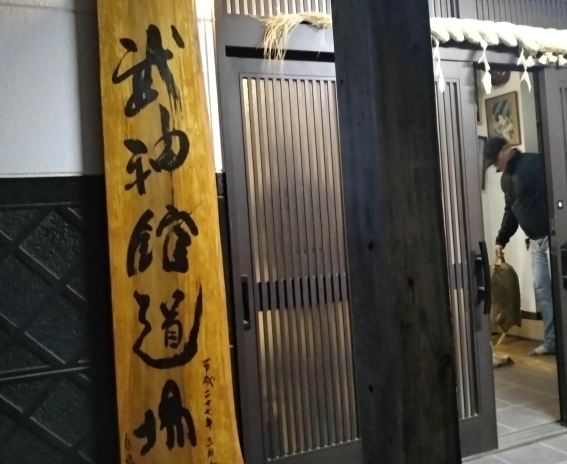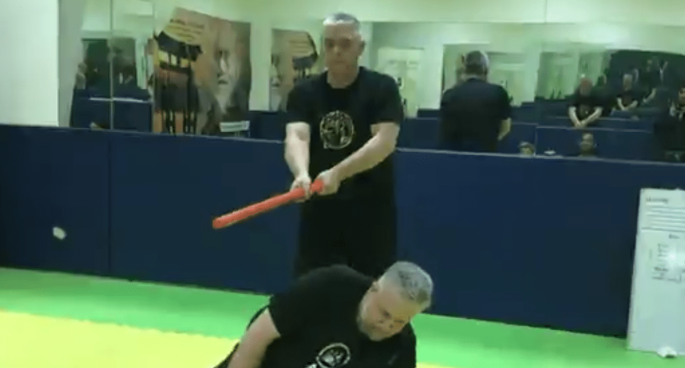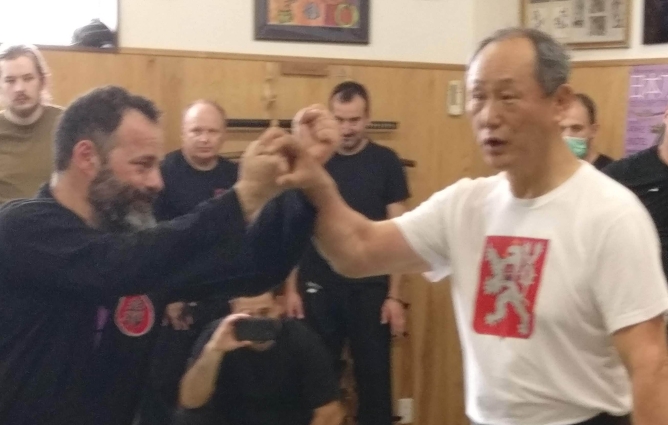From Shiro Kuma by kumafr

The Dōjō was packed last night, and Sensei played a lot with the concepts of Kyojutsu and Kyojitsu. Receiving Tezuka San’s fist, Sensei was controlling him holding only one finger. Tezuka san explained that the control was not on the finger we were watching. Sensei was applying light pressure with his other hand on the shoulder blade. This small pressure was enough to take his balance. Tezuka’s attention focused only on the finger, and he was unable to move and to feel the touch on his back. Hatsumi Sensei is like a magician. He sends false information to distract us from where he is applying the technique.
That is when he spoke about Kyojutsu and Kyojitsu. Everything he does is very subtle, and you can hardly see it from the outside. All is “Mienai,” something that you cannot see. (1)
That questions our perception of reality. What is real, and what is not? This is the focal point of Sensei’s Mutō Dori this year.
But are we really familiar with the words Kyojutsu and Kyojitsu? After a quick check, it seems that many Bujinkan practitioners are not. After class, Tracy Nyholt, Michael Tano and I went for dinner. We agreed to say that few people knew the difference between the two expressions. So, let’s spend some time and explain what Kyojutsu and Kyojitsu are. Kyojutsu is the art or the way to trap the mind of the opponent. (2) And Kyojitsu is the “tool” you use to alternate between truth and falsehood. (3) We can summarize that by saying that Kyojutsu is the set of techniques using Kyojitsu.
Last month, Sensei said that “Sometimes it is important to know how to lie, but do it with a pure heart. Lying will help you to guess when something is right or wrong”. The art of Kyojutsu is an essential aspect of the fight. Deception is a powerful technique, and history is full of examples. During world war 1, the General Bugeaud, a French officer, said: “during the war there are rules, but they are very few.” But be careful. As for everything in life, what you do depends on your goals. This is why you must have strong ethics and sound morality.
Two Japanese expressions will help you get what Sensei means by Kyojutsu.
The first one is “Kyojitsu Konkō.” It is a mishmash of truth and untruth; a mixture of fiction and fact, creating an opening in Uke’s mind and body.
The second one is even better. It is “Kyojitsu Himasu.” “The difference between truth and fiction in art being very subtle; Art abides in a realm that is neither truth nor fiction.” This is the perfect definition of what Sensei is teaching now.
When I say “teaching,” please remember what he says at every class: “I do not need any more students, I teach to the Dai Shihan.” Everyone is still welcomed to class whatever his rank. But he is more showing than actually teaching. Yesterday, he asked us to watch his movements, and it is ok if we don’t understand. Sensei teaches “Ishin shoden,” i.e., through a direct transmission one to one. (6)
So if you wonder what your reality is, then all the above might help you to find your answer. You are the master of your life, and your choices are the good ones. Create your reality because no one can tell what to do.
Sensei is an artist, and the Bujinkan is art.
And art “abides in a realm that is neither truth nor fiction.”
______________________________________________
1 見えない, Mienai: invisible.
2 虚術 Kyojutsu: falsehood + art; technique; means; way; trick; trap; plot; stratagem; magic.
3 虚実, Kyojitsu: truth or falsehood.
4 虚実混交, Kyojitsu Konkō: a mishmash of truth and untruth; a mixture of fiction and fact.
5 虚実皮膜, Kyojitsu Himasu: The difference between truth and fiction in art being very subtle; Art abides in a realm that is neither truth nor fiction.
6 医心正伝: correct and direct transmission from “heart to heart.”
Registration for the Paris Taikai 2019 are good with already over 50 participants from 11 countries. Register today to save 15% and join us! CLICK HERE…
Read More


